A fresh salmon poke recipe with options! How to make fresh salmon poke at home! This post includes everything you need to know about sourcing fish, as well as a recipe for delicious salmon poke.
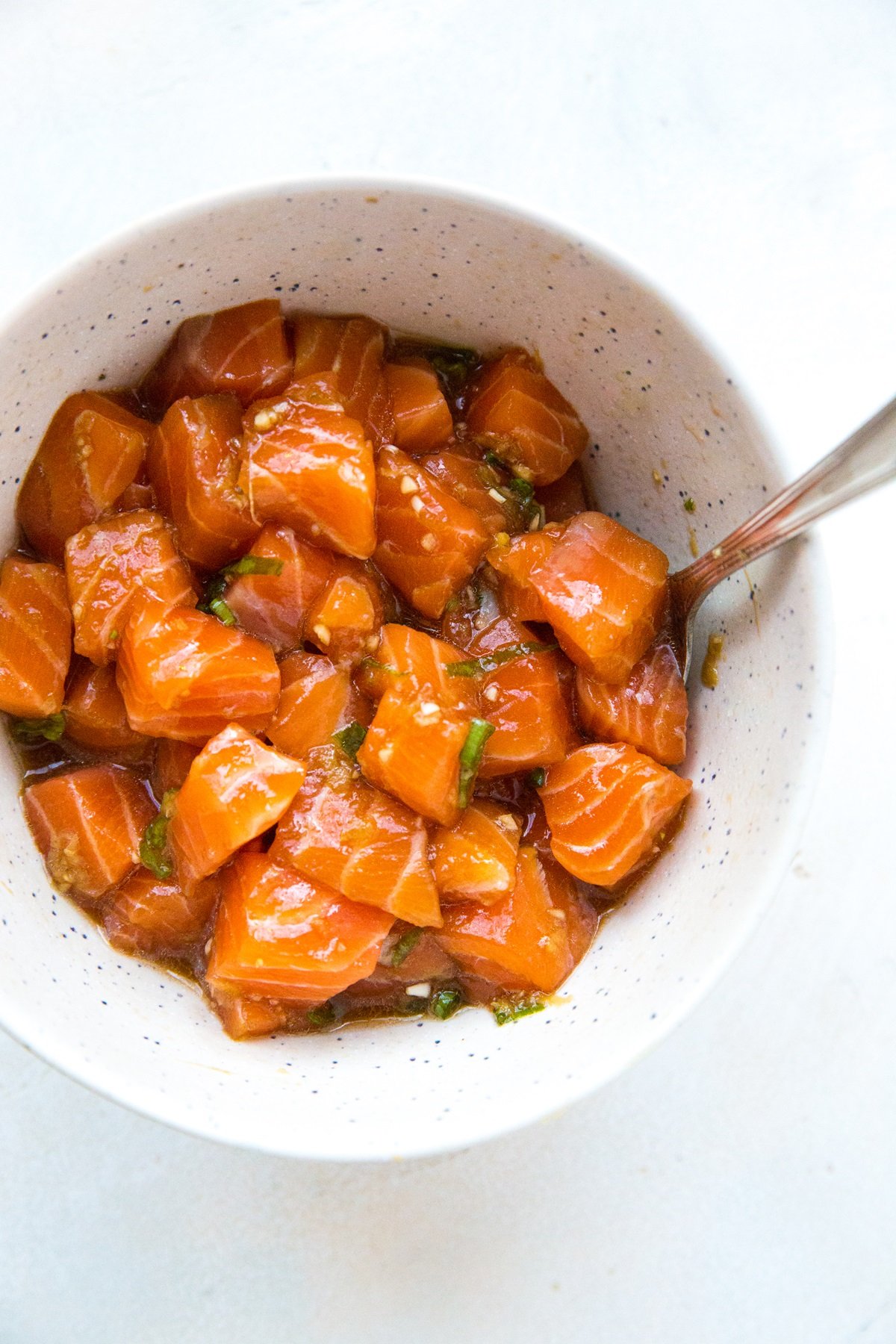
Do you dabble in the raw fish?
Over the last couple of years, I have been in the habit of cooking most of my meals at home, although I have a special place in my heart carved out for going out to all-you-can-eat-sushi. If you ever have the opportunity to visit Reno, going out to one of our many AYCE sushi restaurants should be first on your To Do list!
Using this interesting time as an opportunity to try new techniques, meals, flavors, etc in the kitchen is a great way of turning an otherwise dull situation into a pretty glorious one!
Enter: Salmon Poke. And Sushi Burgers. And All the fusion food.
If you saw my post a couple of days ago for Gluten-Free Rice Buns, you know I recently made sushi burgers using salmon poke. For those of you who dabble into raw fish and sushi, I figured I would share my go-to method for making salmon poke
First, some basics:
Is Making Poke Risky?
Yes and no. Primarily no. As long as you buy sushi-grade salmon (the salmon will explicitly state on the packaging, “sushi grade”) and you are careful with the way you prepare it, it is completely safe.
I go to a seafood supply company here in Reno, where they keep a freezer of sushi-grade fish. It is important that you buy the fish frozen.
Not only do seafood supply companies freeze the fresh fish at a lower temperature than your freezer will go in order to kill parasites, but they are the ones familiar with the sourcing and processing.
In this sense, don’t go buying regular fish from the grocery store…this is where you can get yourself in trouble.
Be sure to use a clean cutting board and a clean surface when cutting the fish. Don’t leave it out for an extended period of time. In other words, when you’re ready to make poke, make poke…and then eat it. This will ensure any bacteria that happens to be floating around your cooking surface won’t contaminate the fish.
This is no different than preparing any other meat or vegetable for that matter, but it is worth mentioning so that you stay mindful of good cooking hygiene practices.
When in doubt, don’t do it.
How to Thaw Sushi-Grade Fish:
Best practice is to thaw frozen sushi-grade fish in your refrigerator. In other words, don’t thaw it at room temperature on the counter, and don’t thaw it in water. Allow it to completely thaw in your refrigerator, and once thawed, use it immediately.
Can I Save Leftovers?
I don’t. When I make any sort of raw fish adventure, I always consume it at the exact time. In all likelihood, you are probably fine saving it in the refrigerator overnight and eating it the next day for lunch, but I personally wouldn’t risk it.
Okay, so we all ate poke and it was a blast. What now?
Sanitize anything that same into contact with the raw fish. Again, this is a precautionary measure as there should have been nothing alive in the fish to begin with, but just to be safe and hygienic, sanitize.
This means sanitizing the cutting board you used for chopping the fish, the bowl you used for mixing everything, and all of your counter top surfaces. It takes two seconds, don’t freak out.
Ingredients for Salmon Poke:
Here is what you need to make salmon or ahi poke at home! Note that all of this should be to taste. In essence, use more liquid aminos/soy sauce if you love salty umami flavors, more or less ginger depending on your affinity for it, etc.
Sushi-Grade Salmon (or raw Ahi Tuna): Be sure to source your sushi grade fish wisely! If you don’t have a way of obtaining sushi-grade salmon that is frozen upon purchase, I don’t recommend making poke at home. Speak to the seafood person at the store you go to in order to ensure you’re getting sushi quality fish.
Fresh Ginger: a little heat and zing comes from fresh ginger! If you aren’t familiar with fresh ginger, use a vegetable peeler to peel the brown outer skin, then use a zester or the fine side of a grater to grate it.
Sesame Oil: Toasted sesame oil gives poke a nice robust nutty flavor and also helps keep the sauce thick. You can skip it if you don’t have it on hand, but it really gives the poke a lot of amazing flavor.
Coconut Aminos/Liquid Aminos/Soy Sauce: That salty/umami flavor comes from liquid aminos or soy sauce. I use either liquid aminos or coconut aminos for a soy-free gluten-free option, but you can absolutely use soy sauce if it’s what you have on hand.
Sriracha or Red Chili Sauce: Sriracha sauce adds a touch of heat, which is nice for rounding out the full palate. If you’re spice averse, stick with a small amount, or add as much as you need to please your heat index.
Rice Vinegar: We need a little tang in our salmon poke, so rice wine vinegar is my go-to tang-infusion. You can also use cider vinegar or lime juice, but I find rice vinegar provides that authentic sushi-tasting experience.
Green Onion: A little zip an pizzazz is what green onion provides! Don’t skip it if you don’t have to!
Sesame Seeds: I add sesame seeds for a bit of texture and some added nutty flavor. In my opinion, they don’t provide much more than a textural element, so its fine to skip them if you’re okay with less texture.
Optional Add-Ins:
- If you like your poke on the creamy end, add 2 to 3 tablespoons of mayonnaise (I recommend avocado oil mayo because it’s less gross than regular mayo).
- Like your poke sweet and sour? Add 2 teaspoons of pure maple syrup to offset the umami and heat.
- If you have wasabi paste at home, toss it in! Wasabi generates a great deal of flavor. Just be sure you don’t use too much. I would start with 1 teaspoon and go up from there.
- Lover of garlic? Add one small clove, finely minced!
- If you’re preparing a salmon poke bowl, be sure to prepare your bowl ingredients such as sushi rice, edamame, sauces, avocado, and any other poke bowl toppings you enjoy.
How to Make Salmon Poke:
Thaw sushi-grade salmon in your refrigerator until completely thawed. Place the high-quality salmon on a clean cutting board on top of a clean counter top. Use a sharp knife to remove the salmon skin.
You can either discard the salmon skin or do as I do and cook it in a cast iron skillet until crispy and eat it! It tastes amazing in my opinion…I call it bacon of the sea 😉
Chop the salmon into bite-sized pieces. I like chopping it into small pieces, but you can go for larger cubes if you’d like.
Place cubed salmon in a mixing bowl (or regular large bowl).
Stir together the ingredients for the sauce in a measuring cup or bowl and pour over the chopped salmon. Stir well until everything is combined. Taste the salmon for flavor and add more of anything you’d like!
Enjoy in a poke bowl with sushi rice or brown rice and/or on top of a green salad. Now that you know how to prepare poke, let’s discuss more details.
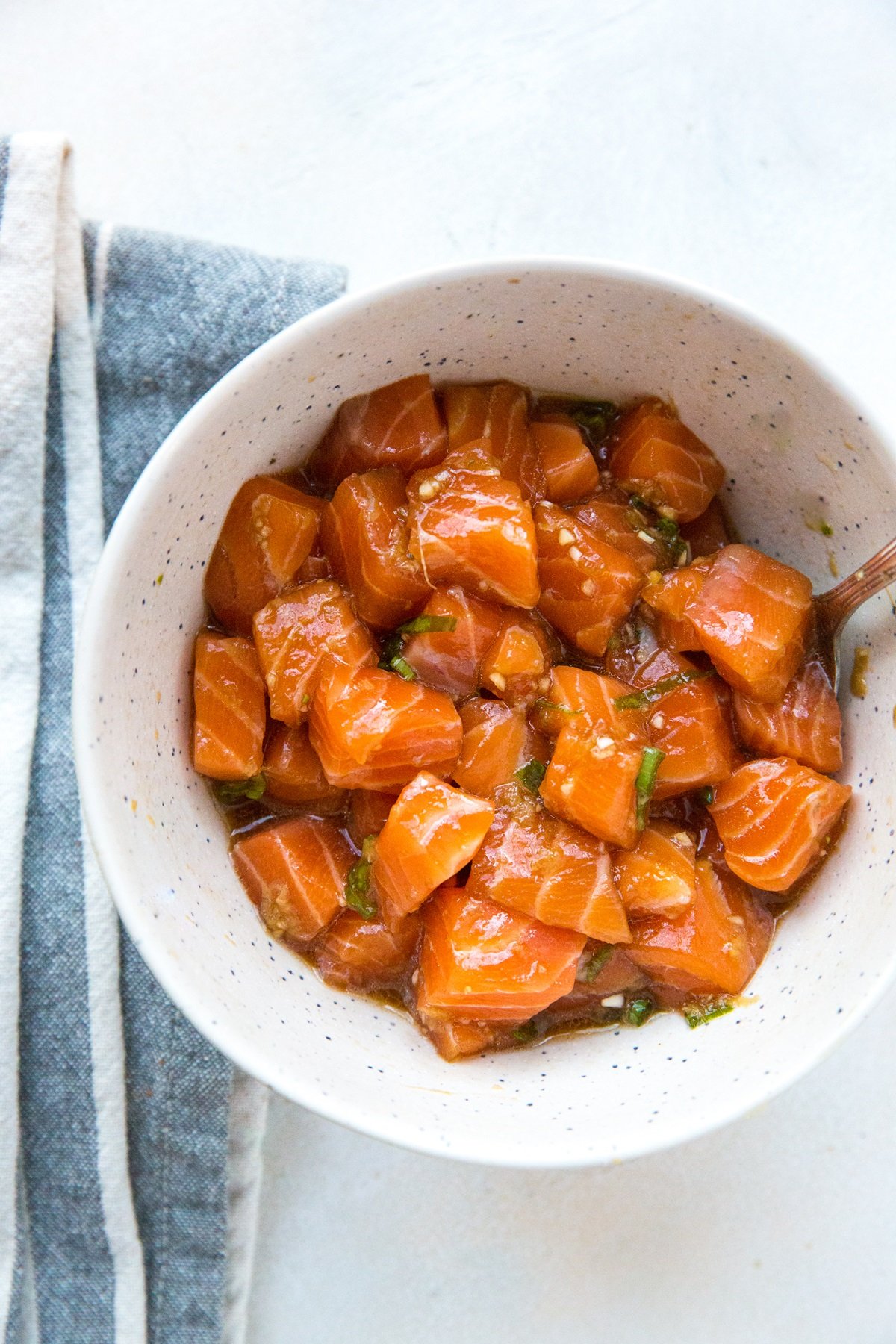
Should You Fear Fish?
When I visited Copper River Salmon in Cordova, AK a number of years ago, the folks behind the operation mentioned there is a lot of fear surrounding preparing fish and seafood at home. I get it. No one wants to deal with a parasite. They aren’t any shade of a good time.
As long as you stay mindful about properly cooking fish that isn’t sushi-grade, or using sushi-grade fish when leaving it raw, there is no higher risk in preparing it at home than there is in cooking a burger.
In fact, eating a raw salad is far riskier than cooking a salmon fillet to completion at home!
The reason I bring this up is not to cause you to go rogue and cook all the fish and seafood at home willy nilly without being careful, it is to dissolve any fear you have surrounding the process. If you have questions, drop me a comment!
Can You Eat Raw Fish When Pregnant?
No, don’t do it. That is all. Raw fish can contain listeria, which can cause severely harmful side effects to fetuses.
How to Serve Poke:
Make your own poke bar! For best results, make the rice ahead of time so that it can chill in the refrigerator.
Serve poke (salmon, yellowfin tuna, etc.) on top of rice as a salmon poke bowl recipe with spicy mayo, ponzu sauce, sriracha mayo, gluten-free soy sauce or sauces of choice.
Select your rice base such as cauliflower rice, jasmine rice, sushi rice, short-grain brown rice, etc. with the rest of your toppings. My favorite toppings are mango, edamame, avocado, green onions, cucumber slices, seaweed salad, and crab salad.
You can also serve raw salmon poke on your Rice Buns for a sushi burger approach with crab salad (recipe for crab salad using REAL crab coming soon), seaweed salad, avocado, etc.
Make a spicy salmon poke bowl recipe with red pepper flakes, sriracha sauce or any of your favorite savory sauces.
You can also enjoy poke on a green salad, or eat it as an appetizer with Baked Wonton Chips. Get creative with how you enjoy your carefully crafted poke, then report back to me on what you do, please!!
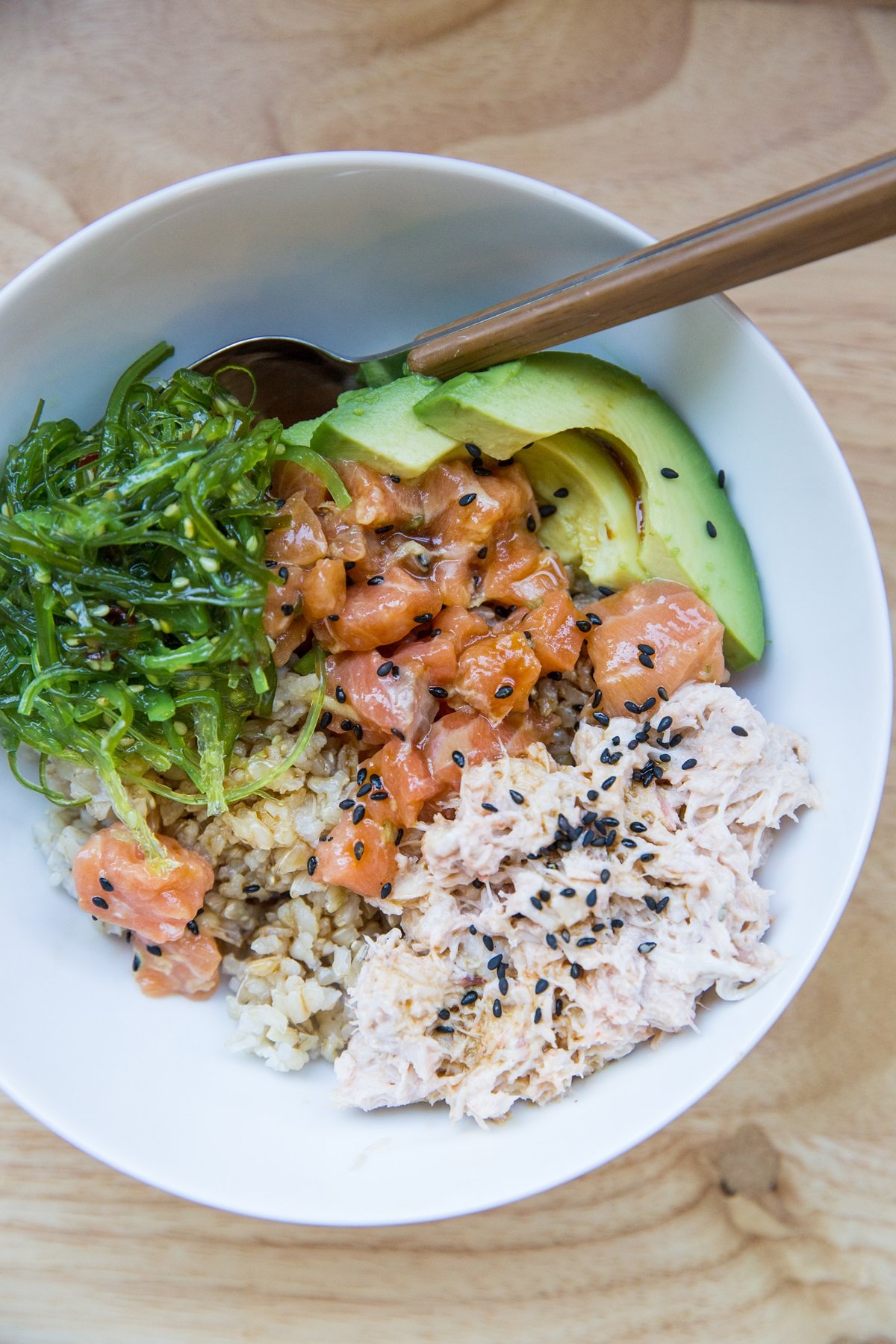
ENJOY!!
Please, please leave me a comment or send me an email if you have any questions or concerns!
More Raw Fish Recipes:
Poke bowls for life!
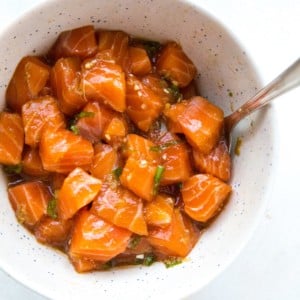
Salmon Poke Recipe
Ingredients
- 1 lb sushi-grade salmon
- 2 tsp fresh ginger peeled and grated
- 1 Tbsp toasted sesame oil to taste
- 2 tsp rice vinegar to taste
- 2 to 3 Tbsp liquid aminos to taste
- 1 to 3 tsp sriracha to taste
- 2 stalks green onion finely chopped
- 2 tsp sesame seeds
- sea salt to taste
Instructions
- Obtain sushi-grade salmon (packaging should specify “sushi grade” and it should be frozen upon purchase).
- Thaw sushi-grade salmon in your refrigerator until completely thawed. Place salmon on a clean cutting board on top of a clean counter top. Use a knife to remove the salmon skin.
- Chop the salmon into bite-sized pieces. I like chopping it into small pieces, but you can go for larger cubes if you’d like.
- Place salmon in a clean mixing bowl (or regular bowl).
- Stir together the ingredients for the sauce in a measuring cup or bowl and pour over the chopped salmon. Stir well until everything is combined. Taste the salmon for flavor and add more of anything you’d like!
- Enjoy in a poke bowl, sushi burger, and/or on top of a green salad.
Video
Nutrition
This post contains affiliate links, which means I make a small commission off items you purchase at no additional cost to you.
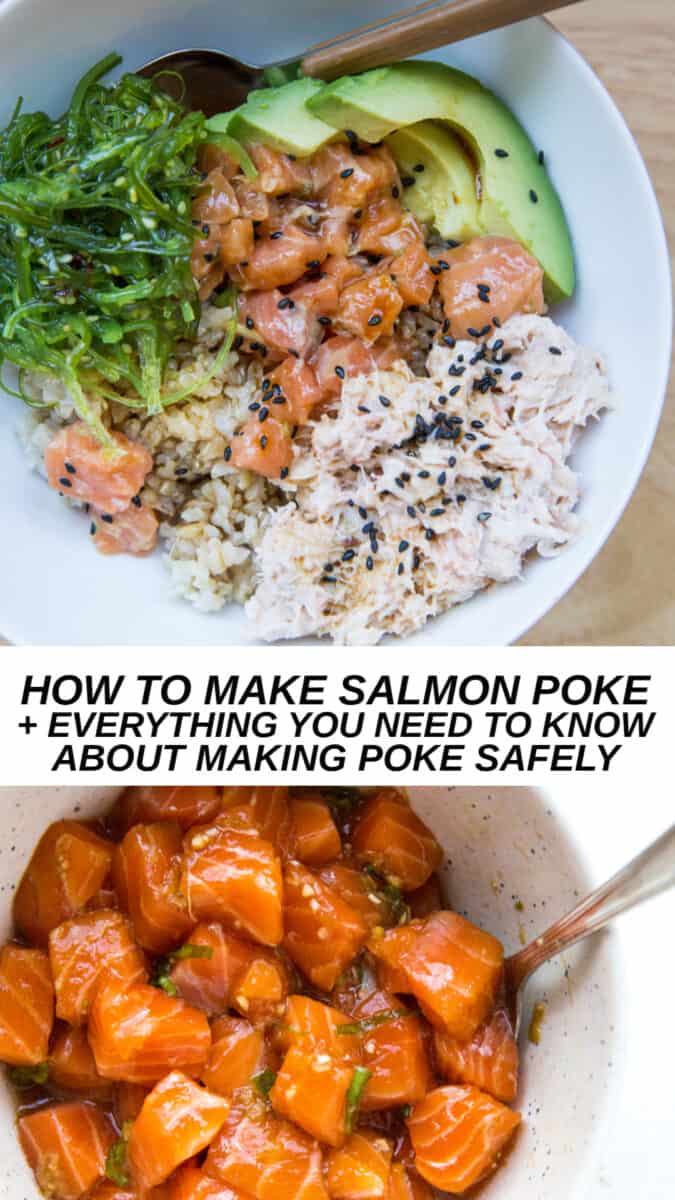


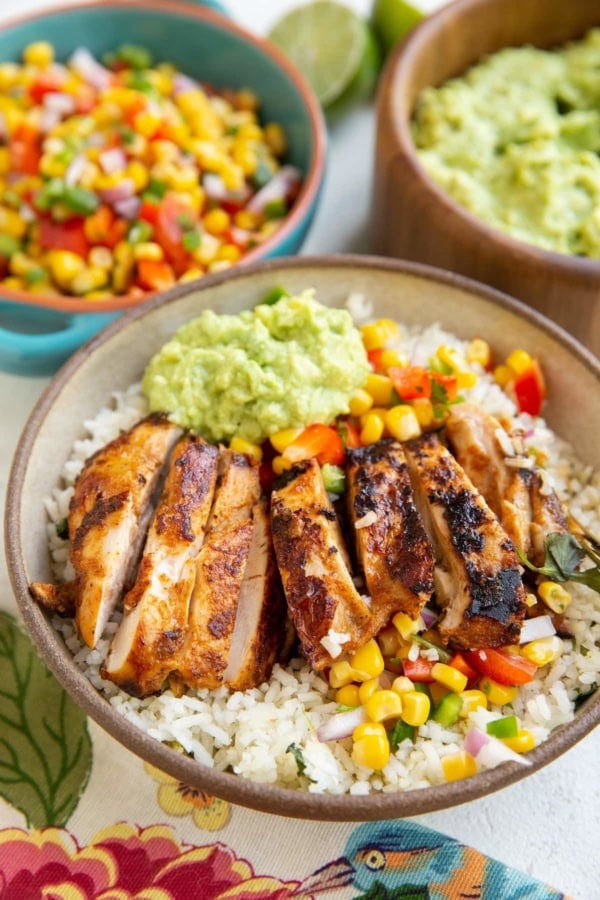
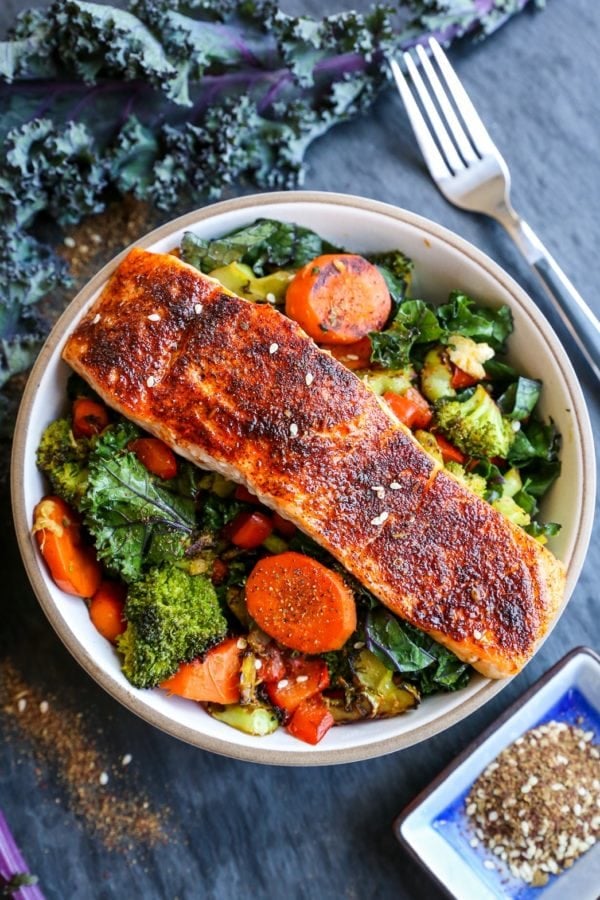
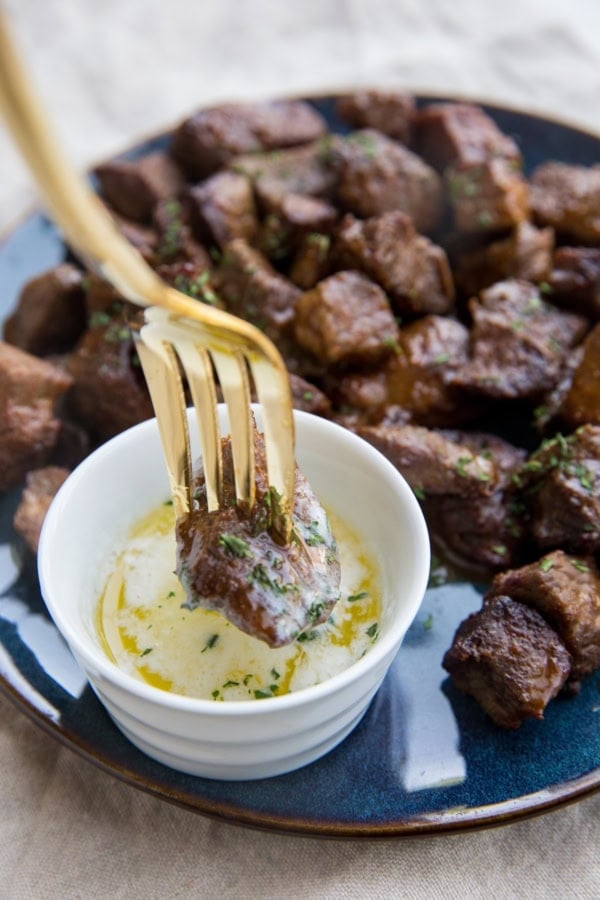









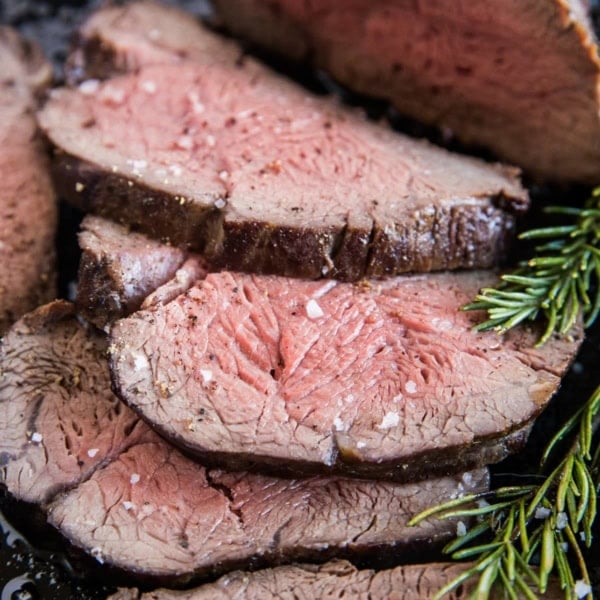
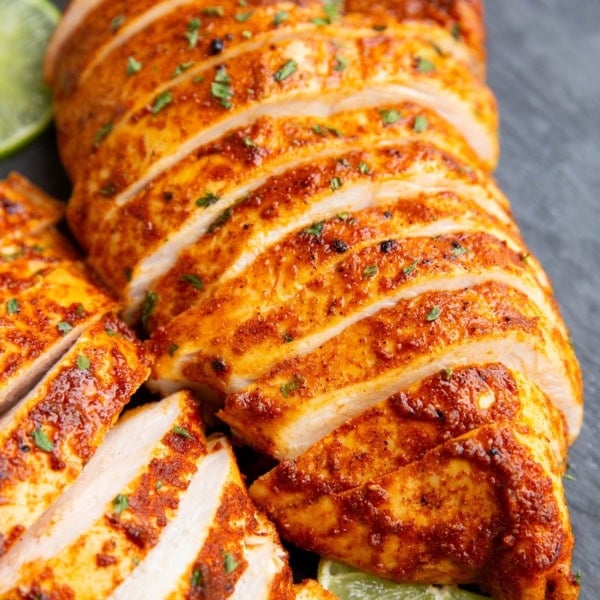

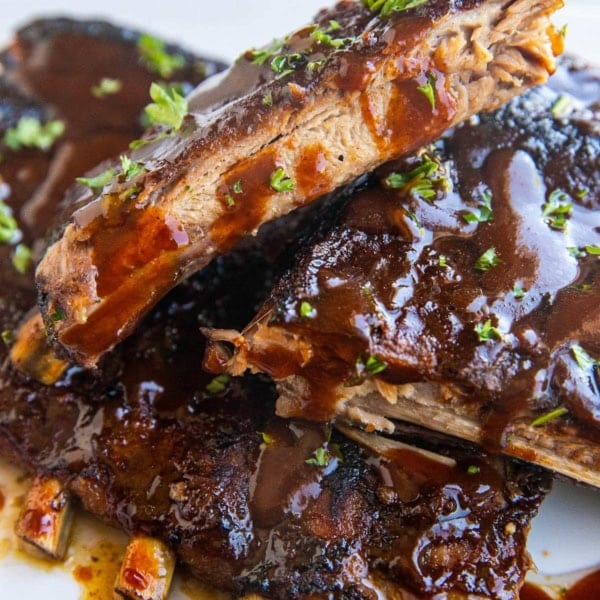
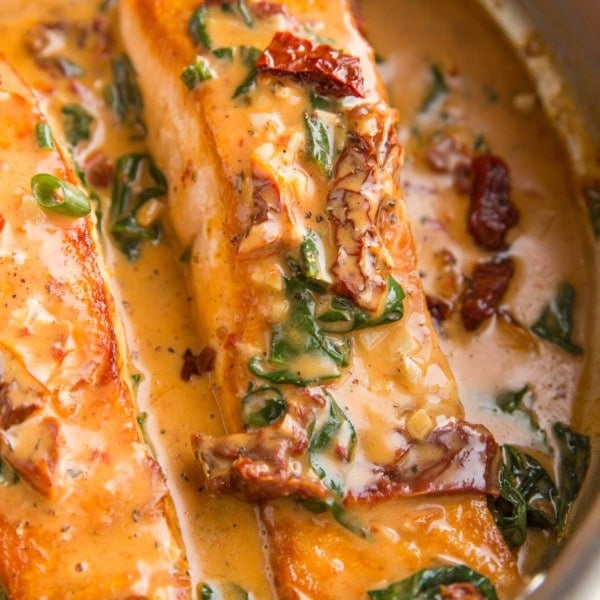
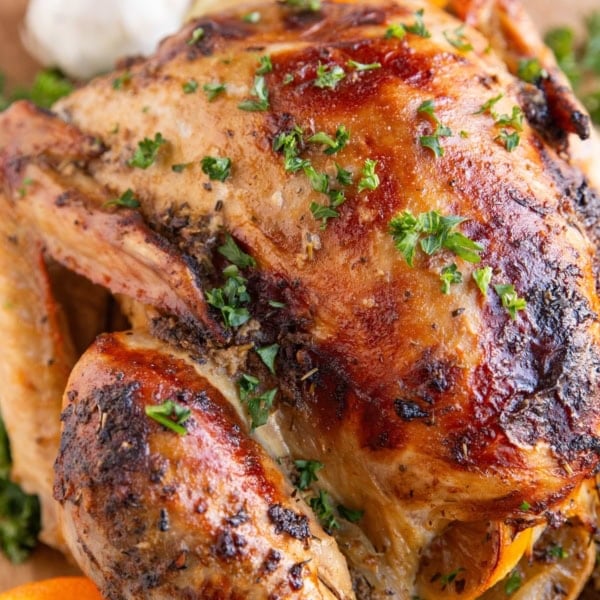
Love this recipe, thank you
My pleasure!
It doesn’t say which ingredients should be in the sauce! Do I need to use the sesame oil there? The srirasha? …
Hi Santiago! The sauce includes everything but the salmon. So, fresh ginger, sesame oil, rice vinegar, liquid aminos, sriracha, chopped green onion, and sesame seeds. Hope that helps!
A tip i have if you looking for sushi grade sushi. You dont really need to look for it. Just get you local smoke salmon from the grocery store, it will work fine if not better(add more flavor). Have fun cooking guys~~~
Can’t wait to try
Yaay! Hope you enjoy! xo
Very interesting! I’ve never heard of poke before and yes, I’m one of those finicky about uncooked meats. Thank you for outlining so patiently for people like me 😉.
I’m newly opening up my cuisine to fish, so maybe in 5 years I’ll be ready for to try this! Thank you again!
My pleasure, Crystal! I totally understand the need for caution when it comes to raw fish, so you’re definitely in great company! Hope you enjoy the recipe once you try it! xo Let me know if you have any other questions!
What store in reno do you reccomend to source your sushi grade fish??
Hi there! I buy mine from Sierra Gold Seafood off of Greg in Sparks: https://sierragoldseafood.com/
Hello! I just wanted to say that I laughed out loud when, after making this recipe tonight, I noticed the word Reno as you were sharing about AYCE sushi. I live in Reno too and thought “I thought AYCE sushi was only a Reno thing” and then realized you WERE talking about Reno! Awesome! Well thanks and hello neighbor!
Hello, neighbor! When I was younger, I thought every place I’d visit would have AYCE, but alas, no! We’re blessed here in Reno!! xoxo
Absolutely must get sushi grade, and stay away from wild salmon if eating raw (there is a high chance that it has parasites, and your typical home freezer won’t kill them off!)
Costco has salmon that is farm-raised in Norway on an antibiotic-free diet. Very high quality and, if you read about that salmon, checked often for parasites and general health of the fish.
Saw this and made it right away – Perfection! I just love it when I have all the ingredients, or nearly, (used Furikake seasoning for green onion).
Don’t get Sushi grade salmon cos it is frozen Salmon for 7 days -4’ F (-30 C) and it’s more expensive. Just freeze it at home for 7 days with above temperature.
Good recipe except you do not soy
Farm raised salmon is tested for and always free of Anisakis parasites. Farm raised fish eat a dry fish food that is cooked and does not have any live parasites in it so it is safe and free of them. These Anisakis worms can be spotted with your eyes and are very common in sushi grade wild fish. Many experienced Japanese chefs will simply remove them before serving sushi to guests. Yes, freezing does kill them and make the fish safe to eat but then you are also eating dead worms in your thawed fish. Hamachi or Yellowtail tuna is always farm raised in Japan and sold only as sushi grade in the US. Many grades of bluefin tuna are caught and sold all over the world as “sushi grade” to get the highest price but the best Bluefin is sent to Japan to be auctioned off and rarely comes back to the US except at exorbitant prices that you will not see at a standard high grade US fish merchant. What makes bluefin tuna sushi grade is simply how it is caught and processed using lines and electric harpoons to stun the fish so it does not exhaust itself fighting a sport fisherman and create off flavors. Very few Americans have tasted true Japanese quality sashimi tuna as it commands such a high price that few US customers would ever be willing to pay for it.
In the Honolulu fish markets, poke bowls were made from fresh fish that could not be sold as sushi as it was from off cuts prepared from unsellable fish fins, collars and bones left over from carving up the big fish for sale to Japanese buyers who always paid top prices for the best pieces of these scarce large fish. Also octopus and squid plus shellfish made for extremely popular and tasty poke but is uncommon outside of Hawaii. This scraping of meat from fins and bones often made the tastiest poke and Japanese chefs still make the spicy salmon and tuna used in rolls from minced fish left over after prepping the much more expensive “sushi grade” fish. I can still taste the fresh quality of a quart plastic container of tuna poke sold for less than 4 dollars in the early 1980’s Honolulu Fish Market. A quart of poke per person was just the right amount.
I found your recipe delicious alternative to the usual Hawaiian Poke. I loved the delicate flavor of the green onion much less assertive than the usual Sweet/red onion that most recipes use.
I did substitute Lao Gan Ma Chili Crisp (1 Tbsp) for the Sricha, and also light soy sauce for the Aminos.
So happy you stumbled on my recipe, Claire! I’ve never tried Lao Gan Ma so I’ll have to pick some up and give it a whirl! Thanks so much for the sweet note! oxoxo
@Julia, laoganma chili crisp used to only be available to buy from online Asian food stores (at least in my area it wasn’t available in stores for the past 12 years) but now Walmart sells it in the Asian food section. It’s highly addictive, but watch out for the MSG content!
Great article. It just takes common sense when preparing raw fish. I find it better to buy farm raised salmon for freshness and no parasites. We eat 3 – 4 day old poke whether it be ahi, salmon, mahi mahi, or aku. Just take out of the fridge how much you’re gonna eat and return the rest. Pupu’s for the week!
That’s such great information! Thank you for sharing! Now I’ll make bigger batches of poke so that I can save it…truly brilliant! xoxo
@Kua, https://www.captainjacksalaska.com/seafood/pc/catalog/salmon_diseases.pdf
Do you serve right away or let it marinate?
I cover it with plastic wrap and refrigerate it for about 15-20 minutes before serving 🙂 Hope you enjoy! xoxo
I tried the recipe and the vinegar made it too overwhelming. I didn’t even put it into my salmon for fear of ruining it.
Hi Cyn,
Sauces are often overwhelming before they’re mixed with other things.